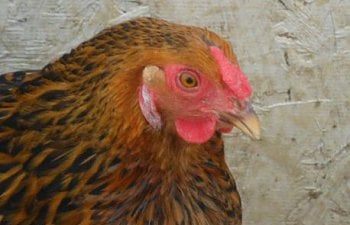Rose combs are interesting comb shapes found in breeds like the Wyandotte and the Dominique. These combs are not as tall as the more common single comb making them less likely to get frostbite. But how and why do these breeds have rose combs and is it possible for them to have single combs? Well it is all about genetics.
Rose and single combs are inherited as two types of comb on one gene. The traits are not sex-linked and the inheritance pattern is straightforward.
Every chicken inherits a pair of genes. One from the rooster and one from the hen. While the sperm from the male and the ovum from the female are developing, each pair of genes divide so that the sperm and the ovum have one of the pair of genes. This is called meiosis.
Genotypes and Phenotypes
Having a rose comb is dominant which means that there is more of a chance to have this trait. While having a single comb is recessive. We use a "R" to represent the dominant trait of having a rose comb and a "r" to represent the recessive trait of having a single comb. These are genotypes. But each chicken has a pair of genes so there must be two symbols.
For example, a Wyandotte with a rose comb either has the genotype "RR" or "Rr". If it had the genotype "rr" then it would have a single comb. Even though the genotype "Rr" has the recessive trait for single combs (r) in it, it does not show because the dominant trait for rose combs (R) over powers it.
Phenotypes are things that you can see. Rose and single combs are the phenotypes.
Homozygous and Heterozygous
When a trait has two symbols that are the same such as "RR" or "rr" we call it homozygous. When a trait has two symbols that are different such as "Rr" we call it heterozygous.
You can not look at a chicken with a rose comb and tell if it is homozygous or heterozygous because it has the possibility of being either "RR" or "Rr". However, if a chicken has a single comb, the only possibility is "rr". Therefore we know that they are homozygous.
Punnett Squares
Punnett squares help us understand how genes are passes from parents to their offspring.
This is what the punnett square would look like if a homozygous rooster, with a rose comb, was crossed with a homozygous hen, with a rose comb.
All offspring are homozygous with rose combs.
However if either the rooster or hen was heterozygous then the punnett square looks a little different.
or
The offspring still all have rose combs but some may be heterozygous and carry the single comb gene.
If both parents are heterozygous with rose combs, the punnett square looks like this.
75% of their offspring will have rose combs but 25% will have single combs.
Since you can't tell by just looking at a chicken if it is homozygous or heterozygous, a breeder or hatchery could cross two heterozygous Wyandottes and end up with a single comb Wyandotte! This does not happen very often because there is only a 25% chance, but it is possible.
Meet Barbara!
Barbara is a year and a half old Golden Laced Wyandotte from Mt. Healthy Hatchery. Unlike the other four Golden Laced Wyandottes, she has a single comb. She stands out in the flock and she could never be shown but it does not effect her laying or health.
Could a Barred Rock ever have a Rose Comb?
Since a single comb is a recessive trait, a chicken with a single comb has the genotype "rr". Therefore if two chickens with single combs are crossed the punnett square looks like this.
Their offspring will always have single combs. Sorry Barred Rocks, you are stuck with single combs.
Genetics are a very confusing and interesting subject. I hope that you have learned something about the genetics behind rose and single combs.

Check out my other articles! -------> Here!

